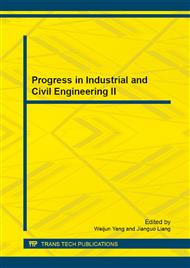p.304
p.310
p.316
p.322
p.326
p.331
p.336
p.342
p.349
Influence of Dilation on the Axial Load of Bolt as Joint Subjected to Shearing
Abstract:
Based on the load transfer mechanism of bolts, the relationship between the axial load and shear displacement of bolt changing with the dilatancy of joint was analyzed, then the theoretical solutions of axial load of the bolt were verified by the direct shear test of bolted rock mass with different normal stress (0.5MPa, 0.7MPa, 1.0MPa) applied on the joint. The results show that the calculated values fit well with the results of tests; the increment of dilation angle can enhance the axial force of bolt quickly, but decrease the length of crushing failure zone.
Info:
Periodical:
Pages:
326-330
Citation:
Online since:
September 2013
Authors:
Keywords:
Price:
Сopyright:
© 2013 Trans Tech Publications Ltd. All Rights Reserved
Share:
Citation:


